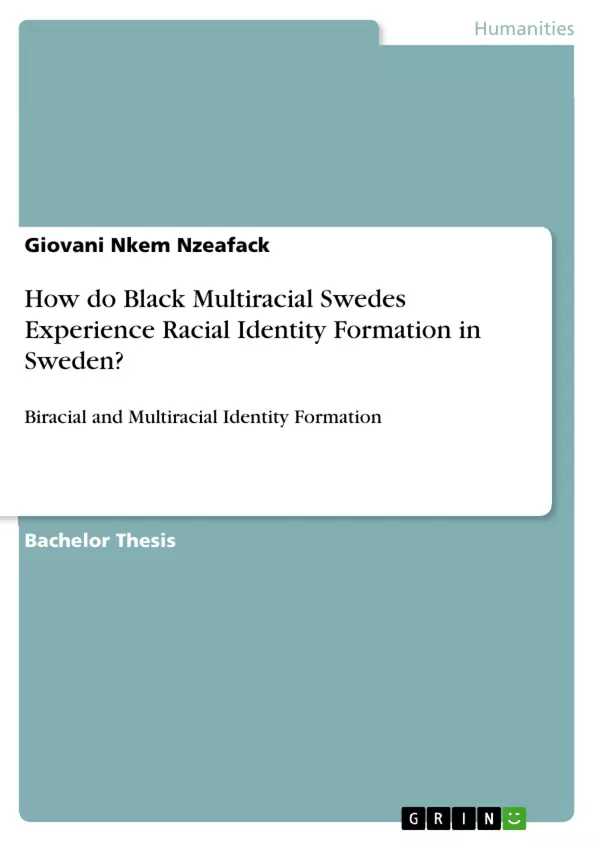This thesis examines how biracial and multiracial individuals experience racial identity formation in Sweden. An investigation was conducted into their childhood and upbringing to explore how these experiences shape the way that their identity is formed. To arrive at the results of this dissertation, six individuals who self-identify themselves as Black biracial Swedes were recruited to participate in the data collection process.
This mean that this research has used primary tools such as semi-structured interviews to collect data from the participants. This study has used two contemporary positive theories of biracial and multiracial identity formation which are Poston’s Biracial identity model and Roots resolution for resolving otherness. Within these two theoretical frameworks, the research question and aim was answered through analysis of the respondents. Themes that were used to analyse the interviewees responses where alienation from racial identity, picking a side, language as identity and, familiar support and negative experiences. The results finding shows that most interviewees experience a challenge in the process of identifying themselves with a specific racial group leading to a development of a gap in the process of self- identification.
Inhaltsverzeichnis (Table of Contents)
- Abstract
- Chapter 1: Introduction
- Problem Statement
- Research Aim and Research Question
- Key Terms and Concepts
- Chapter 2: Literature Review
- Biracial Identity Development: The Global Context
- Biracial Identity Development: The Swedish Context
- Chapter 3: Methodology
- Constructivist Approaches
- Qualitative Approaches
- Recruitment and Analysis
- Sample Demographics and Representativeness
- Validity and Reliability
- Limitations
- Researcher Positionality
- Chapter 4: Theoretical Framework
- Poston's Biracial Identity Development Model
- Root's Resolution for Resolving Otherness
- Application
- Chapter 5: Analysis
- Alienation from Racial Identity
- Picking A Side
- Language as Identity
- Familial Support and Negative Experiences
- Chapter 6: Discussion and Conclusion
- Bibliography
Zielsetzung und Themenschwerpunkte (Objectives and Key Themes)
This thesis explores the experiences of biracial and multiracial individuals navigating racial identity formation in Sweden. Through interviews with six Black biracial Swedes, the research aims to understand the challenges and resolutions these individuals face in developing their sense of self.
- The challenges and complexities of racial identity formation for Black multiracial Swedes.
- The impact of societal perceptions and expectations on the process of identity development.
- The role of family, cultural background, and personal experiences in shaping biracial identity.
- The influence of language on identity formation and belonging.
- The importance of recognizing and addressing the unique experiences of biracial individuals in Sweden.
Zusammenfassung der Kapitel (Chapter Summaries)
Chapter 1 provides an overview of the research problem and sets out the research aims and questions. It establishes the context for the study by highlighting the increasing ethnic diversity in Sweden and the lack of research on biracial identity within this context. The chapter also introduces key terms and concepts relevant to the research. Chapter 2 delves into the existing literature on biracial identity development, examining global perspectives and focusing on the specific context of Sweden. This chapter explores the challenges and complexities faced by individuals with biracial identities. Chapter 3 outlines the methodology employed in the study. It describes the constructivist and qualitative approaches used in the research, including the recruitment process, data collection through semi-structured interviews, and the analysis techniques employed. Chapter 4 presents the theoretical framework underpinning the study. It introduces Poston's Biracial Identity Development Model and Root's Resolution for Resolving Otherness, which are used to analyze the experiences of the participants. Chapter 5 presents the analysis of the interview data, focusing on the themes that emerged from the participants' narratives. It explores topics such as alienation from racial identity, "picking a side," language as identity, and the role of familial support and negative experiences. Chapter 6 concludes the study by discussing the findings and their implications. The chapter reflects on the key themes that emerged from the analysis and offers insights into the experiences of Black multiracial Swedes in forming their racial identities.
Schlüsselwörter (Keywords)
This research focuses on the experiences of Black multiracial Swedes, exploring their unique journey of identity formation. Key terms and concepts include biracial identity, race, ethnicity, cultural identity, discrimination, and the impact of social and cultural context on individual experiences. The research utilizes two frameworks for analysis: Poston's Biracial Identity Development Model and Root's Resolution for Resolving Otherness.
- Quote paper
- Giovani Nkem Nzeafack (Author), 2021, How do Black Multiracial Swedes Experience Racial Identity Formation in Sweden?, Munich, GRIN Verlag, https://www.grin.com/document/997368



